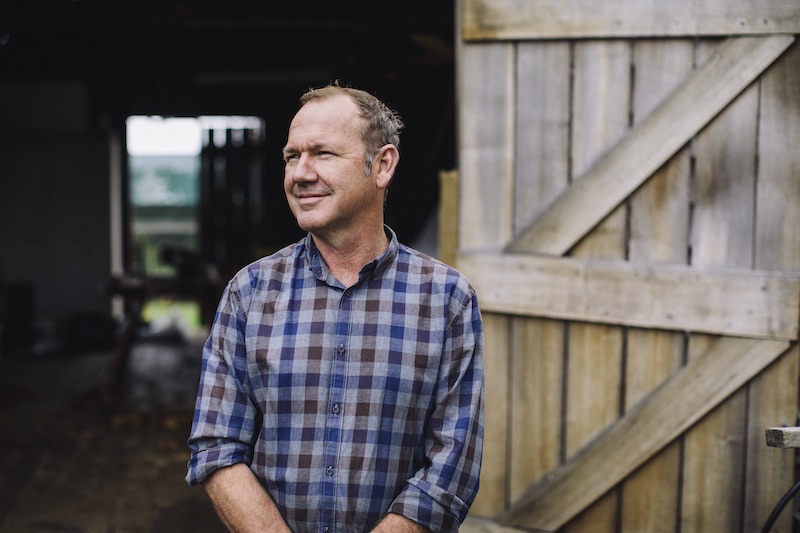Philip Wolfhagen: In Our Nature
Philip Wolfhagen is a master of the atmospheric. Over decades, he has used the picturesque surrounds of his Tasmanian countryside home to become one of Australia’s most collected painters.
Words: Briony Downes
Photography: Jesse Hunniford
PHILIP WOLFHAGEN’S TIES to the Tasmanian landscape are strong. The son of a wool grower, he spent the majority of his childhood living in the Midlands, a vast area in the centre of the state filled with farmland, craggy mountain ranges and waterways. Following a brief sojourn in Sydney for university, Wolfhagen returned to the country town of Longford in Tasmania’s north. His studio is perched on the top floor of a convict-built flour mill and it is there that Wolfhagen has produced many of his now iconic paintings.
With a background in printmaking, Wolfhagen came to painting via a chance discovery of the open-air oil sketches of English painter John Constable. Mesmerised by Constable’s depictions of clouds, Wolfhagen learnt how to paint and soon found the forms of nature were the ideal avenue for what he wanted to explore. He now works with a palette of subdued primary colours and mixes his paints on glass, a process that allows for a crisp, even hue without tonal variation. He adds beeswax to his oil paints to allow fluidity (and a hint of nature in the work itself).
“The newest ideas I am working on are multi-panelled compositions. They are also some of my oldest ideas,” says the artist. ”I have worked in this way on and off for 28 years, since my cloud studies painted at Sydney College of the Arts in 1990.”
Wolfhagen is no stranger to awards and his work has been widely and consistently collected. Newcastle Art Gallery possesses one of the largest selections of Wolfhagen’s work and in 2013, together with the Tasmanian Museum and Art Gallery, they produced Illuminations, a national touring survey show spanning nearly three decades of his career. In 2017, Wolfhagen was the recipient of the Lloyd Rees Art Prize and his major work, A Litany of Vapours (2007) was acquired by the National Gallery of Australia. Described by then NGA director Gerard Vaughn as Wolfhagen’s “magnum opus”, A Litany of Vapours is a seven- panelled tribute to clouds gathering around the heights of Ben Lomond near Launceston.
There is no doubt Wolfhagen is an expert at the atmospheric. He has held a longstanding fascination with the works of 19th century artist Caspar David Friedrich and French Baroque painter Claude Lorrain. His paintings often reflect the landscape around him; the grey lilac skies of early morning over pasture or the crackling embers of a distant fire. Behind Longford, the majestic rock formations of the Great Western Tiers and Central Plateau stretch the length of the horizon, their ancient dolerite peaks breaking up the landscape into unpredictable terrain. It is a view that has been studied intently by Wolfhagen for more than 20 years. “Overlying the rocks with their hexagonal fissures is a fragile vegetation that requires a careful rendering to bring out its subtle beauty,” Wolfhagen says.
At home, the artist tends a magnificent garden full of fresh produce and sculpted topiary. For Wolfhagen, the process of gardening and growing complements his painting practice. “Apart from the obvious landscape links, each practice is focused on recreating the world according to personal aesthetic principals,” he explains. “Whilst painting is more immediate, I probably take more risks with plants. There is also the critical element of time in gardening – you have to take a longer view of things.”
Continuing to explore the themes of light, natural forms and landscape, Wolfhagen is working on a series of paintings that he evocatively calls “nocturnes”. They follow on from “the drama and intensity” of his 2017 exhibition Hinterlands at Hobart’s Bett Gallery, and feature the dark forms of ageing trees. “The landscape pathos of dead eucalypts are powerful images that just have to be painted,” Wolfhagen says. “They serve as very appropriate allegories for my concerns about threats to the environment and the consequences of a changing climate.”
There is a personal element to some of the new works. Autumn Noctuary: an elegy for M.C.W. (2018), for example, is not only a homage to autumn but also an embodiment of reflection and great loss. It was recently exhibited in the Salon des Refusés at S.H. Ervin Gallery and Wolfhagen reveals some panels took years to complete. “Two of the panels were started as far back as 2010, and each year since I have added panels and made additions to older ones until I felt a sense of completion this April.”
Surrounded by picturesque landscape on all sides of his home and studio, Wolfhagen has used his local environment as inspiration to become one of Australia’s most coveted painters. A single glimpse at the landscape through a window or an image taken from a pile of photographs can remain the source of inspiration for multiple paintings over several years. Currently putting the finishing touches on new paintings for an exhibition at Sydney’s Dominik Mersch Gallery, Wolfhagen concludes: “I am always striving for a deeper understanding of colour and improving my fluency in painting practice.”
Wolfhagen is represented by Bett Gallery in Hobart, Dominik Mersch Gallery in Sydney, Karen Woodbury Fine Art in Melbourne and Philip Bacon Galleries in Brisbane.
This article was originally published in Art Collector issue 85, JUL–SEPT 2018.









